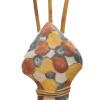The Bagu ceramics were created by artists from the Girringun Art Center, a small town located 124 miles south of Cairns, Queensland. It was not until 2009 that the artists revealed their works to the Australian public at the Cairns Indigenous Art Fair.
The Bagu were originally fire sticks. They were traditionally composed of two parts, the Bagu (body) and the Jiman (stick). The Aborigines of Queensland gave these boards an anthropomorphic shape in homage to the spirit of fire—Chikka-bunnah—who, according to legend, threw burning sticks (jiman) across the sky.
While wood was once used exclusively to make them, the artists at this art center, who are constantly experimenting with new techniques, have recently chosen to use clay.
This work is accompanied by certificates of authenticity from the Girringun Aboriginal Art Center and the Arts d'Australie gallery • Stéphane Jacob, expert in Aboriginal art.
Debra MURRAY
Bagu , 2012
Art : Aboriginal
Origine : Girringun
Dimensions : 16 x 61 x 4 cm
Medium : Ceramic
Price : Nous contacter / contact us
N° : 2520

